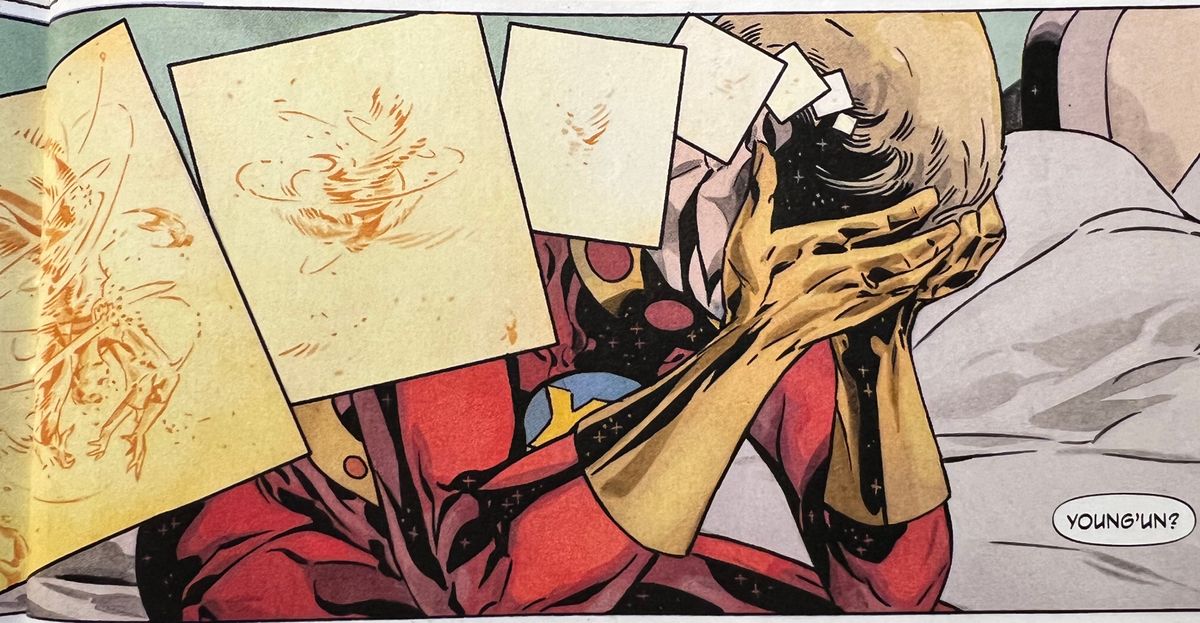An Introduction To the World in Neil Gaiman and Mark Buckingham's Miracleman: The Silver Age #1
Young Miracleman wasn’t resurrected because of who or what he was but because one old man with too much power felt alone and rudderless in the world that he has made.

Decadence is at the heart of Miracleman: The Silver Age #1, Neil Gaiman and Mark Buckingham’s remastering of a thirty-year-old comic before they properly begin the end of their long, long, long delayed story. The world has been remade in the image of Miracleman, a 1950s forgotten superhero who destroyed London but saved the world back in 1984. This story opens in 2003, or 19 E.M. as eras are measured in this brave new world. But it’s 19 years into the age of miracles, a period shaped by man-made superheroes, aliens, and the next steps in mankind’s evolution. Children wearing brightly colored costumes fight over and through an NYC skyline, using the debris to knock each other into buildings while they talk tough, grown up, and heroic. When a Galactus-like threat appears above their playground, the boy declares “If that thing’s going to be defeated, we have to join forces,” to which his rival answers “Okay. But we’ve still got a score to settle, and just don’t you forget it.” Sounds like the writing of Stan Lee or Roy Thomas.
But they’re interrupted by another child, slightly angelic, who has been sent to gather her friends from their playtime. This wasn’t some portentous battle for the fate of the world but children playing dress up, dressing up as superheroes the same ways that kids used to dress up as cops and robbers. Only the New York City and buildings that they destroyed in their playtime seem all too real. “Renovations later. Rematch tomorrow,” they decide as they race to witness the next step of history being taken– the resurrection of Young Miracleman.

These opening pages set the stage for the rest of Gaiman and Buckingham’s story. Young Miracleman, or Dicky as his only friend Miracleman calls him, was killed back in 1963, the discarded experiment of his original makers. But in this age of miracles, he’s resurrected by an alien. But why? For what purpose other than to soothe an old man’s soul? For 19 years, Miracleman had been at the center of rebuilding the world around him, the center of his universe. So why resurrect a ghost of the 1950s into this new day and age?
“Because you deserved a second chance at life,” Miracleman tells the disoriented boy. “Because you were my friend. Because you were a part of the Miracleman family.” In his answer, Miracleman shifts the onus of Dicky’s resurrection onto him. It’s because of Dicky’s value as a human. But when Dicky asks about the democratic rule of this glorious future state, Miracleman answers “... There’s just me.” Gaiman and Buckingham pack so much into that line. It says so much more about the world than all the ways that Miracleman has tried to show the world to Dicky. “There’s just me,” is such a loaded statement about who Miracleman is in this world and where his head is at. Young Miracleman wasn’t resurrected because of who or what he was but because one old man with too much power felt alone and rudderless in the world that he has made.

The decadence of this issue is hidden beneath flashy costumes and all too familiar battles but it’s a decadence that comes out of power and privilege. It’s unrecognized by the people who are in the middle of it; it is just the way that the world is, kids flying about and destroying buildings that they can rebuild before bedtime just to destroy again tomorrow. They play with these things the same way that I played with Legos and Star Wars figures, controlling an imaginary world that bent to my whims. When I was a child, I played and spoke like a child. But of course, I didn’t have any real powers and eventually got bored of my Legos and action figures.
The Buckingham of 2022 is a great artist for this because he can capture the emotional center of Young Miracleman and Miracleman on an almost instinctual level. His Young Miracleman’s smile shows an outer optimism but the way that he follows the character’s eyes as he takes in this new world tells us his confusion but also his distaste for this future that he’s found himself in. It’s the same with Miracleman; Buckingham draws him as a character who’s trying to convince himself that he’s doing the right thing as opposed to just being selfish and wanting a friend who reminds him of the old days.
Miracleman: The Silver Age #1 shows us a world that looks beautiful and perfect on the surface. The bad guys have been defeated and the good guys have claimed the world as their reward. For 19 years, they’ve been benevolent gods walking the Earth and giving all of us their gifts and love. And what do they demand? Just that the world is theirs. But is that enough? Gaiman and Buckingham are telling a story about a character (Miracleman) getting everything he wants and then still wanting more. And it’s horrible to think that the more that’s wanted (Young Miracleman) may not have any agency in his own life here and instead just be a wish rather than a real boy.






Comments ()